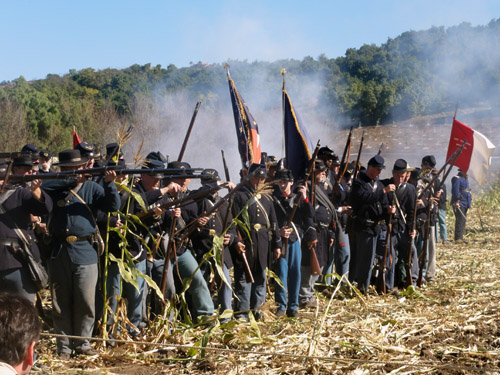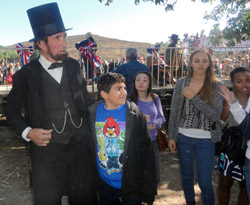
By Donald H. Harrison

MOORPARK, California –Reflecting on a Civil War reenactment that was staged at the Underwood Family Farms here, I found myself focusing on two lessons from the proceedings. First, a mistake may snowball into a disaster. And second, charisma can outlast even death.
Our nation is now observing the sesquicentennial of the Civil War. One of the most devastating battles of the war–for both the Confederate and Union armies–was the Battle of Antietam (known to the Confederates as the Battle of Sharpsburg) in which 22,000 soldiers were killed on September 17, 1862.
Over the Veterans Day Weekend, re-enactors depicted different phases of that battle in which forces led by the generals Robert E. Lee of the Confederacy and George B. McLellan of the Union fought to a bloody draw as McLellan with vastly superior numbers defended against Lee’s attempted incursion northward into Maryland.
The phase of the reenacted infantry and artillery battle that I witnessed along with family members was called the “Bloody Run.” It was a series of skirmishes until units on the left side of the Confederacy’s line made the mistaken assumption that the withdrawal of Union forces facing them across the battlefield signaled the enemy’s retreat. In fact, according to the re-enactment’s narrator, the Union soldiers had withdrawn only to gather their ranks and to tighten their battle formations.
At this point, however, commanders on the Confederate forces’ left side withdrew their men from the field. Observing this, the Union Army sent forces from the right side of its line on a flanking maneuver enabling them to encircle the Confederate line, whereupon killing their opponents was like “shooting sheep in a pen.”
On Sunday, Nov. 11, there were sounds of cannon and rifles, and costumed actors who had been standing fell to the ground to signal that they had been killed or wounded. Mercifully for the little children perched on the shoulders of their parents watching from the sidelines, the real horrors of war–blood, agonizing screams, limbs torn apart–were omitted from the reenactment. It was more like watching a chess game, with human pieces, than watching the carnage that is war, and one can only hope that in the future all our children will be spared experiencing, the true gore of war.
Imagine if the Confederate commanders on the left side of the line had not made the false assumption that the Union Army had retreated. Might the course of the battle–even history–have been changed? According to materials distributed at the reenactment, sponsored by the Rotary Club of Moorpark, unbeknownst to the participants in the real battle of Antietam, British representatives had decided that if the Confederates had one more victory in the war, Great Britain would offer formal mediation. This process, implying recognition of the Confederacy, might have prompted other countries to recognize, even help the Confederacy, and have led to the permanent sundering of the United States, according to the Rotary Club’s publication, The Blue and Gray Civil War Journal.

Besides learning how costly a battlefield mistake can be, people who attended the early afternoon proceedings on Veterans Day, also had the opportunity to watch Abraham Lincoln impersonator Don Ancell, in full costume, somberly deliver the Gettysburg Address. Afterwards the actor passed out little bookmarks which reprinted the short speech, and which corrected some myths that have grown up around Lincoln’s best known address.
First, it said, it’s not true that the speech was written on a train on the way from Washington to Gettysburg. In fact, Lincoln composed it several days before its delivery and it was written on White House stationery and not, as the myth goes, on the back of an envelope.
With the Steven Spielberg movie Lincoln currently hitting movie theatres following a large television advertising build up, there are a few interesting firsts about Abraham Lincoln to be found on Ancell’s bookmark. Five “firsts” of Lincoln were that he was the “first president to grow a beard;” “first to have a portrait on coins;” “first to give out Medal of Honor;” “first and only to obtain a patent for an invention;” and, sadly, “the first to be assassinated while in office.” Wikipedia provides the necessary amplification: Lincoln’s patent was for a mechanical invention to help lift boats over shoals.
One-hundred forty-seven years after his assassination, Lincoln is still a charismatic figure. This is demonstrated not only by the new movie starring Daniel Day Lewis that is expected to draw large crowds across the nation, but also by the clusters of parents and children who gathered around Lincoln impersonator Ancell here in order to have their photograph taken with him. Such a photograph is truly a wonderful keepsake, and it made me wonder what costumed figure from Jewish history would similarly gather such a crowd around him or her? Abraham? Rebecca? Joseph? Moses? Samson? David? Solomon? Theodore Herzl? Henrietta Szold? Albert Einstein? David Ben-Gurion? Golda Meir?
Shor and I had traveled up to Agoura Hills for a family visit, but immediately agreed to the suggestion that we drive as a group up to Moorpark to see the Civil War re-enactment. Although I have watched the reenactment of the Battle of San Pasqual, from the Mexican-American War, at the state historic monument near Wild Animal Park in San Diego County, this Civil War reenactment was on a much larger scale. It stirred the imagination and the conscience.
*
Harrison is editor of San Diego Jewish World. He may be contacted at donald.harrison@sdjewishworld.com .